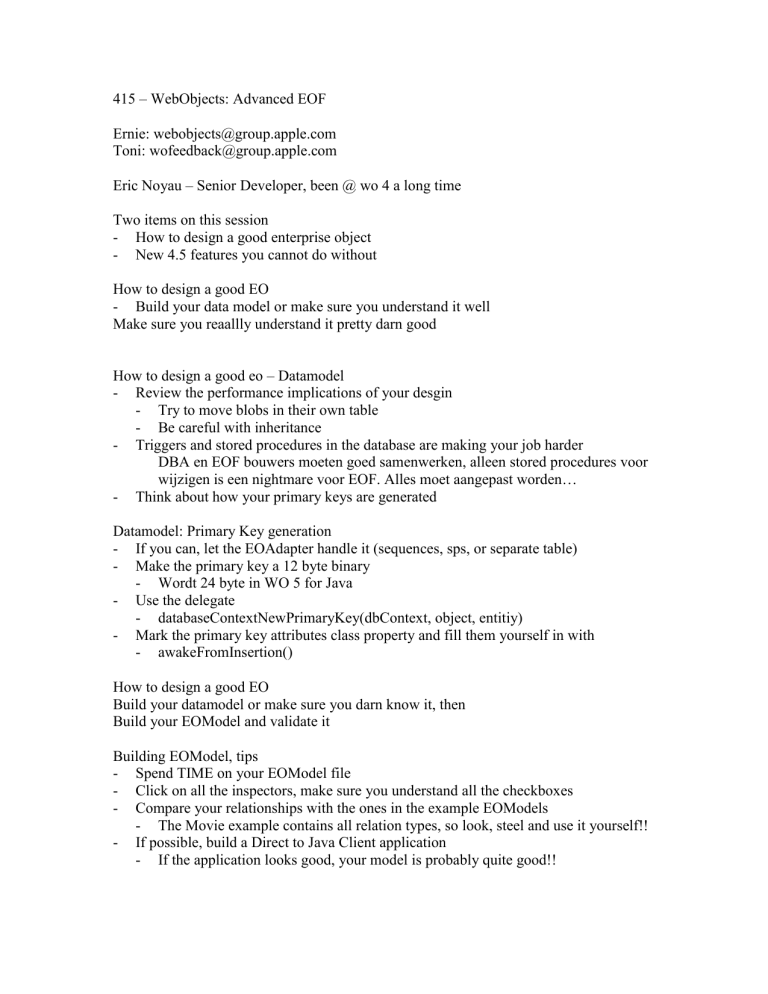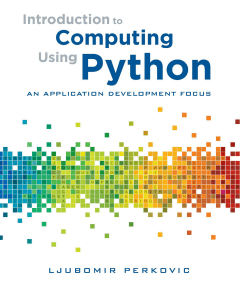
415 – WebObjects: Advanced EOF
Ernie: [email protected]
Toni: [email protected]
Eric Noyau – Senior Developer, been @ wo 4 a long time
Two items on this session
- How to design a good enterprise object
- New 4.5 features you cannot do without
How to design a good EO
- Build your data model or make sure you understand it well
Make sure you reaallly understand it pretty darn good
How to design a good eo – Datamodel
- Review the performance implications of your desgin
- Try to move blobs in their own table
- Be careful with inheritance
- Triggers and stored procedures in the database are making your job harder
DBA en EOF bouwers moeten goed samenwerken, alleen stored procedures voor
wijzigen is een nightmare voor EOF. Alles moet aangepast worden…
- Think about how your primary keys are generated
Datamodel: Primary Key generation
- If you can, let the EOAdapter handle it (sequences, sps, or separate table)
- Make the primary key a 12 byte binary
- Wordt 24 byte in WO 5 for Java
- Use the delegate
- databaseContextNewPrimaryKey(dbContext, object, entitiy)
- Mark the primary key attributes class property and fill them yourself in with
- awakeFromInsertion()
How to design a good EO
Build your datamodel or make sure you darn know it, then
Build your EOModel and validate it
Building EOModel, tips
- Spend TIME on your EOModel file
- Click on all the inspectors, make sure you understand all the checkboxes
- Compare your relationships with the ones in the example EOModels
- The Movie example contains all relation types, so look, steel and use it yourself!!
- If possible, build a Direct to Java Client application
- If the application looks good, your model is probably quite good!!
Step 3 of good EO
Implement your logic
- EOGenericRecord
- No Code
- No logic, just the data
- Custom Eos
- More powerful, full fledged objects
- Maintenance, if(modelChanged), changeObject
- Subclass EOGenericRecord: less maintenance and improved Java performance!!!
Public class Foo extends EOGenericRecord {
Public final string Name;
Public void name(String name) {
Return (String)storeValueForKey(name);
}
}
Key Value Coding:
Get: zoekt naar methodes: String name(),String name, String _name(),String _name
Set zoekt naar setName(String), String name, _setName(String), String _name
Store Value Coding:
Get: String _name(),String _name, String name(),String name
Set: ook omgedraaid tov value coding
Voordeel: Eigen code wordt eerst aangeroepen, voordat er wordt ge-upload…
Public static boolean canAccessFieldsDirecty()
Public static boolean shouldUseStoredAccessors()
In WO 5 for Java: nu doet obj-c gewoon what the fuck is private?? Gewoon ophalen, in 5
(Java), kan dat niet.. Dus components worden gecontroleerd op private / protected
Implement your logic:
- validate your attributes
- public Object validateName(Object value) trhows EOValidation.Exception
- Validate your EO
- Public void validateForSave()
- Public void ValidateForDelete()
- Public void ValidateForInsert throws EOValidation.exception
-
Call super()! No update!
Called only at the event or request/response loop
-
Methods you can implement:
- public void unableToSetNullForKey()
-
- public void awakeFromInsertion()
- public void awekeFromFetch()
Methods you should not override:
- public void willChange()
- public void willRead()
Relationship management
- AddObjectToBothSideOfRelationshipWithKey()
Use it everywhere!! It does nice things…
Completion: pres Esc in OSX, F2 in Windhoos
Keep Eos clean
- no EOAccess specific code or
- WOFramework code in your EO
Only exception, EODatabase
This was part 1, how to design a good EO!
- Build your data model and understand it well
- Build EOModel file and validate it
- Implement your logic
Now… for part 2… applause….
4.5 Features:
subclassing EOGeneric record
- Gives performance
- Less maintenance, more flexible
Shared Editing Context!!
EOSharedContext kan ik objecten delen tussen sessies editingContexts…
- Read only!
- Relation destination only
Zelfde als multiple inheritance, ik weet niet naar wie ik moet, sessie1 of sessie 2, en
ook nog: Je kan dan van sessie naar sessie springen.. A big NO NO!!!
- Uniquing scope changed
Snapshot Refcounting
Fetch a context, a snapshot is made, session 2 fetches your object, it takes the snapshot
- Reduce memory footprint
- Help snapshot freshness
- Gotchas
- Ga er niet vanuit dat er altijd een snapshot is!
Snapshot Timestamp
-
Timing your snapshot.. Gebaseerd op de timestamp van object + bepaalde cache-tijd
Every time you create EC, refetch the data
Smaller lagtime, higher freshnes
- Public setDefaultFetchTimestampLag()
- Public setFetchTimeStamp()
Deferred Faulting
- In 4, You fetch the object, and each relation a new object is created, so 50 objs with
10 relationships will create 550 objects (each object + 10 objects = 50 * 11 = 550)
- In 4.5, each object that is fetched, only one object is created for each relationships
- If fetch 50 objects with 10 relations, you create 60 objects (50 fetched + 10 relations)
- It's optional
- Faster Fetches
- WillReadRelationShip()
- EOGenericRecord uses defaerred faulting
Database reconnection
- Automatic on EOADaptor exception
- Modify the behavior by using the delegates
- ReconnectionDictionaryForAdaptor()
- DatabaseContextShouldHandeDatabaseException()
- If switching 2 different database on failure, make sure your SNAPSHOT is
UPDATED!! WO Doet dat NIET!!!
Handling of missing faults
- No exception on fetch
- Empty EO inserted
- Exception thrown on save
- Use the delegates to control the behavior
- DatabaseContextFailedToFetchObject()
Delegatetes made easy
- On EOAdaptor, EOAdaptorContext, EODatabaseContext
- SetDefaultDelegate()
- Do it when you start the app and be done with it!!
LDAP adaptor
- You asked for it…
- No EOModel needed for authentication
- LDAPAdaptor.authenticateUser(userName, password, "bigbird.applee.com",
"cn", "o=Apple Computer", "Subtree")
The end..
FIT IN WITH EOF, DO NOT FORCE YOUR IDEAS OF WORKING EOF HOW TO
DO IT, COINCIDE WITH EOF, NOT FIGHT IT
Q&A
Q: Performance implications on using 12 byte/24byte keys
A: Difference is mostly in blobs, the database is still doing a round trip
Q: Batch Primary Key Generation in WO?
A: no, you can do it yourself
Q: Editing Contexts kan be used multiple one.. It's cheap…
Q: Stored procedure, there's no update sp, will it be there?
A: WO 5.0 is 4.5 in Pure Java
Q: Insert sp, 1 to get Prim Key and the second to do the insert
A: Not yet. Send: [email protected] for feedback/feature requests
Q: How do a timestamp is going to affect optimistic locking
A: It has the exact way of working as it's doing right












